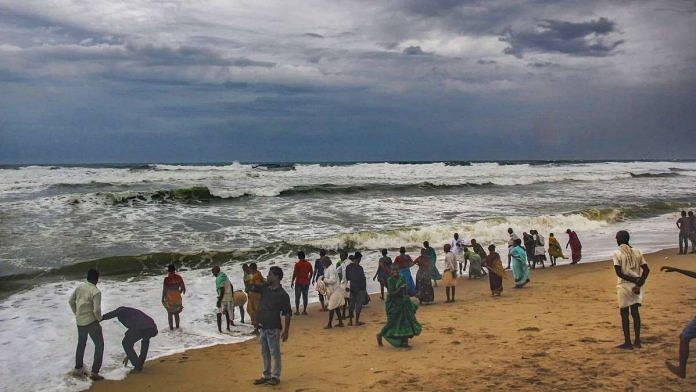Bengaluru: Cyclone Fani (pronounced ‘foni’) is currently edging closer to Odisha, as the state prepares for the onslaught Friday. It has already evacuated 800,000 people amid other emergency measures.
Fani will be the second severe April cyclone in almost 120 years to hit India as it moves along a familiar route to make landfall in Odisha.
The state is no stranger to destruction coming in from the sea.
Last year, Cyclone Titli killed 77 people, destroyed 2.6 lakh hectare of agricultural land, over 60,000 houses, and killed more than 35,000 domestic animals. The flood it caused led to damages worth nearly Rs 3,000 crore.
In 2013, Cyclone Phailin wreaked havoc in the state displacing 11,54,725 people, altering the ecosystem of Chilika Lake and causing damages worth Rs 4,240 crore.
Before that, there was the 1999 Odisha Cyclone — the strongest recorded cyclone ever in the North Indian Ocean. Along with an accompanying storm a few days prior, it brought water from the sea nearly 35 km inland and killed around 10,000 people in the state.
Odisha isn’t alone to suffer the wrath of tropical cyclones. All the other states on the east coast — Tamil Nadu, Puducherry, Andhra Pradesh, West Bengal and even Bangladesh — are also prone to being hit every year.
However, between 1891 and 2018, over 100 tropical cyclones lashed Odisha — the highest number among other states on the coast.
This is drastically higher from the western coast of India, which faces just a third of such storms or fewer.
Also read: Cyclone Fani: Why India’s east coast is a magnet for cyclones
How the storms rise
Tropical storms are those that form between the two tropics and rotate in the anti-clockwise direction. Oceanic water’s surface heats up due to the sun. As warm air and moisture rise up from the surface of warm oceanic waters, more air rushes to fill the space in. This air in turn rises with humidity, creating a cycle of warm, moist air rising up. This system grows in height and size, spreading out and causing a tropical cyclone.
Near India, they form on either side of the country. The ones that form in the Bay of Bengal are quite different and more in number than the ones that form in the Arabian Sea.
The mountains in east Africa tend to direct a lot of winds towards the Arabian peninsula, dissipating heat much more efficiently throughout the Arabian Sea. As a result, this part of the ocean remains relatively cool and produces fewer cyclones. But because of the shape of the land around the Bay of Bengal, the winds are slower and weaker over the ocean.
The Bay of Bengal is fed by a constant source of freshwater in the form of giant rivers like the Ganga and the Brahmaputra. This water that empties into the Bay of Bengal promptly warms up at the surface and rises up as moisture. This makes it difficult for the warm layers of water to mix properly with the cooler layers of water below, keeping the surface always warm and ready to feed any potential cyclone over it.
The post-monsoon (October–December) season sees many more cyclones than the pre-monsoon (March–May) season as before the rains hot dry air moves from land to ocean. This sits on top of the warm water surface blocking the rise of air and humidity, which have no place to go.
Even during the monsoon season (June–September), tropical storms are formed, but the southwest monsoon winds do not allow them to strengthen to cyclone levels.
Also read: Centre releases Rs 1,086 cr to 4 states as advance funds for cyclone Fani
Why Odisha
As a state, the geography and topography of Odisha plays a big role in acting as a magnet for tropical cyclones. Such cyclones and storms in the Bay of Bengal region travel in the northwest direction, upward, owing to the shape of the Indian landmass and the storms’ anti-clockwise spin.
States on the east coast have relatively flatter, plain land as compared to the other coast, preventing any deflection of winds. Because Odisha lies right at the point where India’s coastline curves, its large shore makes for an easy target for most storms.
Furthermore, the Bay of Bengal also welcomes cyclones formed over the Pacific Ocean. As there is no landmass big enough to stop them, they pass through Malaysia and the Gulf of Thailand and enter the Bay of Bengal. They end up circulating here because the Himalayas and the Western Ghats prevent the winds from crossing over.
Unfortunately for Odisha, it simply happens to be just at the wrong place with the wrong orientation where the probability of a storm hitting is high.
A lot has changed since the 1999 Odisha Cyclone. Improved weather forecast and early evacuation has consistently reduced damage caused by cyclones throughout the country. Odisha, however, continues to weather storms that it would rather not.




According to news reports , Cyclone Amphan can reach Andaman And Nicobar Islands by 16 May 2020. Alert warning has been issued by weatherman. Some districts of Odisha have also been alerted on 15 May. In this context , it is apt to refer readers to the alert prediction of this Vedic astrology writer in article – “ Predictions for coming year 2020 by kushal kumar” – published last year 2019 on 10 October at theindiapost.com/articles/predictions-for-coming-year-2020-by-kushal-kumar/. Dates 13 to 16 in May 2020 were indicated on 10 October 2019 requiring more care and appropriate strategy in Andaman And Nicobar Islands and coastal States etc against cyclone-storm. It seems predictive alert published on 10 October 2019 is so close to something becoming fact.